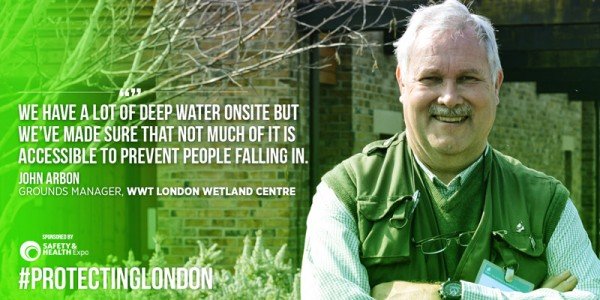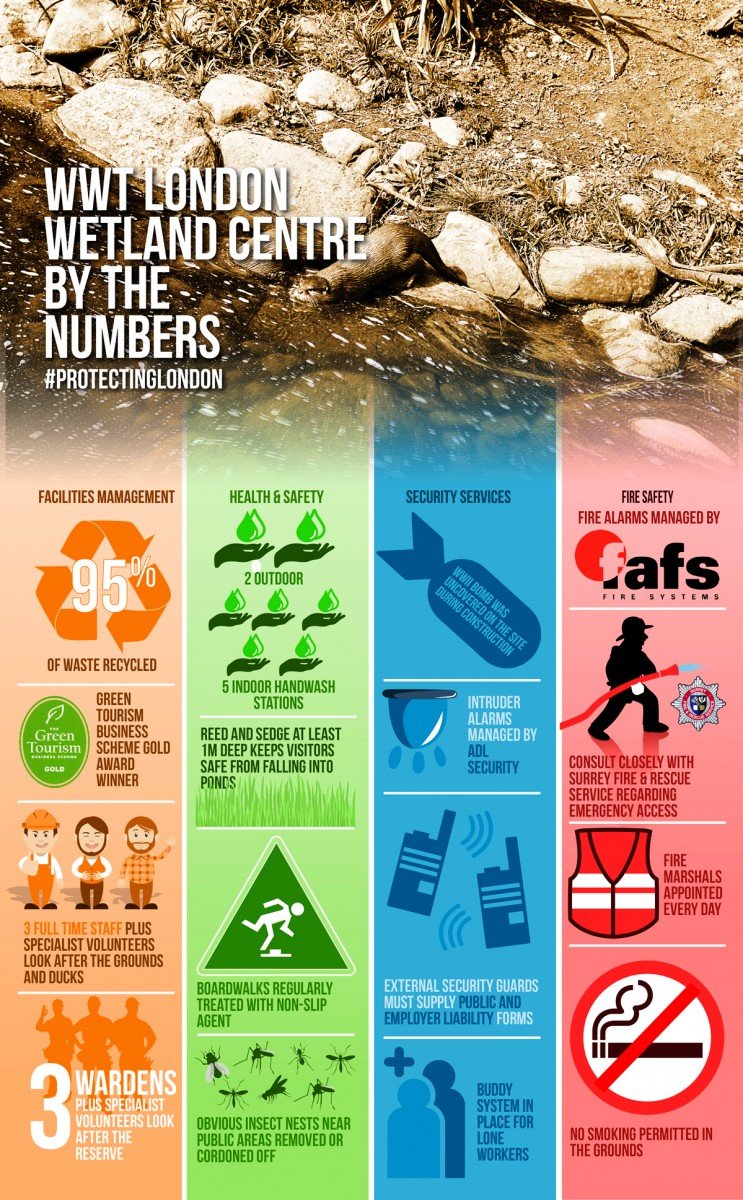Protecting London Episode 5: Health & Safety at the WWT London Wetland Centre
For Protecting London Episode five, we head to the lush urban oasis, the WWT London Wetland Centre. Home to hundreds of species of birds, bats and amphibians, the one hundred acre site is a popular attraction for families, school groups and nature-lovers.
Within the grounds are lakes, gardens, bird-watching hides, a theatre, a cafe and a children’s playground, and it’s the responsibility of Ground and Facilities Manager, John Arbon, to maintain facilities to a standard that ensures everyone can enjoy the grounds safely. John and his team of fifteen staff enable visitors to safely get close to nature, in an environment that has the potential to be very dangerous.
250,000 people visit the London Wetland Centre each year, many of whom are children. They’re protected from slips trips and falls on boardwalks thanks to regular non-slip agent treatment and they’re kept safe in the play area because of systematic audits, but in other parts of the grounds children slip often, and they’re actually encouraged to do so.
Stepping stones across ponds become slippery when wet and children hop across them, often falling in. ‘But we’ve built it in a way that it’s very shallow and if you fall off a stepping stone you’re just going to get a bit wet’, John explains. They’ve made sure it’s not a dangerous activity, just good fun. There are also pond dipping sessions, where visitors get into the water to catch what they can.
‘We are trying to get this idea that the countryside isn’t necessarily a safe place, but it is as safe as you make it.’
 Not all of the water is shallow though; there are plenty of deep ponds on the site. But, John reassures us, the ponds have been graded, so they gradually slope from shallow to deep and you can’t fall straight into dangerously deep water. Marginal vegetation and aquatic vegetation is also used for protection; reed and sedge around ponds is at least one meter deep. ‘So it’s not easy just to walk into a pond’, John explains. And where there is deep water, there is also life-saving equipment.
Not all of the water is shallow though; there are plenty of deep ponds on the site. But, John reassures us, the ponds have been graded, so they gradually slope from shallow to deep and you can’t fall straight into dangerously deep water. Marginal vegetation and aquatic vegetation is also used for protection; reed and sedge around ponds is at least one meter deep. ‘So it’s not easy just to walk into a pond’, John explains. And where there is deep water, there is also life-saving equipment.
As well as plant barriers, there are physical barriers in some parts of the grounds and a lot of safety signs (32 in total), instructing people to stay on the paths. Obvious insect nests near public areas are removed or cordoned off, as are any other areas that could put visitors at risk. Often these barriers don’t only save the people from the grounds, but they save the grounds from the people too.
‘By staying on the path you’re not putting the habitat at risk… Some of that green space is quite rare, quite unusual; it has lots of different flowering plants. So, you don’t want people trampling over it too much, but you do want them to get them as close to it as possible.’
With people encouraged to get hands-on with nature, it’s important for the WWT London Wetland Centre to provide plenty of hand washing facilities throughout the grounds. So there are two outdoor and five indoor hand wash stations, as well as hand gels which people should use when they’ve been in close proximity to wildlife.
 One of the bigger challenges of bringing people closer to nature though, John explains, is finding a balance that suits the wildlife. ‘Wildlife doesn’t always like people, birds can be a bit jumpy’, he tells us, which can be dangerous for people and animals.
One of the bigger challenges of bringing people closer to nature though, John explains, is finding a balance that suits the wildlife. ‘Wildlife doesn’t always like people, birds can be a bit jumpy’, he tells us, which can be dangerous for people and animals.
The safety of the animals is managed by a dedicated to animal management and, whereas the captive animals are quite easy to protect, the wildlife is a little bit more difficult. Catching injured animals can be a dangerous job for staff so really wild animals, to a degree, have to fend for themselves.
Another safety risk for staff is lone-working, which is an inevitable part of the job in a 100 acre site. To tackle this, the team use radio communications for daily operations and have a buddy system in place.
When talking to John, it’s clear that safety of staff, visitors and animals is central to everything done within the grounds. Strong safety measures, sometimes subtle or invisible to the blind eye, mean thousands of people each year can continue to enjoy the grounds and get a little bit closer to nature.
Read more about health & safety in iconic London landmarks, including The British Museum, Royal Albert Hall and Cross, in the Protecting London download report.
Protecting London Episode 5: Health & Safety at the WWT London Wetland Centre
For Protecting London Episode five, we head to the lush urban oasis, the WWT London Wetland Centre. Home to hundreds of species of birds, bats and amphibians, the one hundred acre site is a popular attraction for families, school groups and nature-lovers.
Roz Sanderson
SHP - Health and Safety News, Legislation, PPE, CPD and Resources Related Topics
Yorkshire Water fined £1.6m for sewage pollution
£1.5m fine for Dairy Crest after series of environmental offences
Cleaning up air quality in construction


 One of the bigger challenges of bringing people closer to nature though, John explains, is finding a balance that suits the wildlife. ‘Wildlife doesn’t always like people, birds can be a bit jumpy’, he tells us, which can be dangerous for people and animals.
One of the bigger challenges of bringing people closer to nature though, John explains, is finding a balance that suits the wildlife. ‘Wildlife doesn’t always like people, birds can be a bit jumpy’, he tells us, which can be dangerous for people and animals.